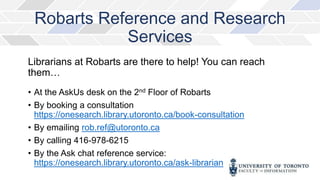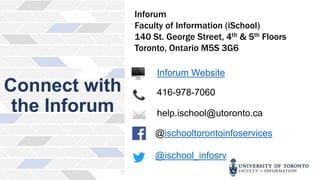This document provides guidance on writing clearly structured academic papers. It recommends that papers include an introduction with a thesis statement, body paragraphs with topic sentences supporting the thesis, and a conclusion. It also offers tips for ensuring writing is grammatically correct, avoids unnecessary complexity or wordiness, and uses an active voice. Structuring papers with clear introductions, topic sentences, transitions and conclusions helps communicate ideas effectively.



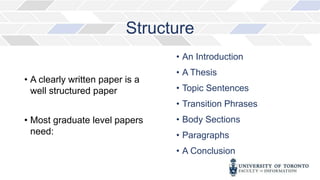
![Introduction
Image source: McAuley, V. (2017). Citizen Lab: Leaks, Hacking, and Fake News [blog post].
Retrieved from: http://digitaltattoo.ubc.ca/2017/07/25/17214/](https://image.slidesharecdn.com/writingclearly-170906001253/85/Writing-clearly-5-320.jpg)
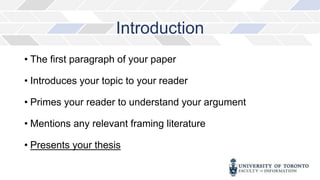
![Thesis
Image source: McAuley, V. (2017). Citizen Lab: Leaks, Hacking, and Fake News [blog post].
Retrieved from: http://digitaltattoo.ubc.ca/2017/07/25/17214/](https://image.slidesharecdn.com/writingclearly-170906001253/85/Writing-clearly-7-320.jpg)


![Topic Sentence
Image source: McAuley, V. (2017). Citizen Lab: Leaks, Hacking, and Fake News [blog post].
Retrieved from: http://digitaltattoo.ubc.ca/2017/07/25/17214/](https://image.slidesharecdn.com/writingclearly-170906001253/85/Writing-clearly-10-320.jpg)

![Transition Phrases
Image source: McAuley, V. (2017). Citizen Lab: Leaks, Hacking, and Fake News [blog post].
Retrieved from: http://digitaltattoo.ubc.ca/2017/07/25/17214/](https://image.slidesharecdn.com/writingclearly-170906001253/85/Writing-clearly-12-320.jpg)

![Body Sections
Section 1
Section 2
Image source: McAuley, V. (2017).
Citizen Lab: Leaks, Hacking, and
Fake News [blog post].
Retrieved from:
http://digitaltattoo.ubc.ca/2017/07/2
5/17214/](https://image.slidesharecdn.com/writingclearly-170906001253/85/Writing-clearly-14-320.jpg)


![Repetition “URL
shortenin
g
service”
“URL
shortenin
g
services”
Image source: McAuley, V. (2017).
Citizen Lab: Leaks, Hacking, and
Fake News [blog post].
Retrieved from:
http://digitaltattoo.ubc.ca/2017/07/2
5/17214/](https://image.slidesharecdn.com/writingclearly-170906001253/85/Writing-clearly-17-320.jpg)

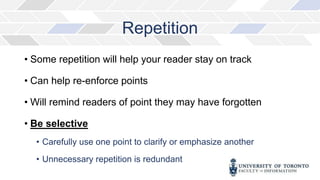
![Paragraphs
Paragraph
1
Paragraph
2
Image source: McAuley, V.
(2017). Citizen Lab: Leaks,
Hacking, and Fake News [blog
post]. Retrieved from:
http://digitaltattoo.ubc.ca/2017/
07/25/17214/](https://image.slidesharecdn.com/writingclearly-170906001253/85/Writing-clearly-20-320.jpg)


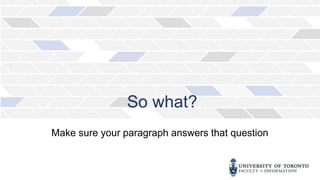



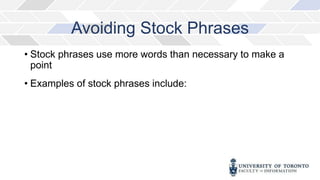
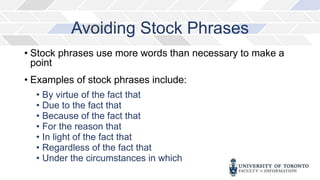





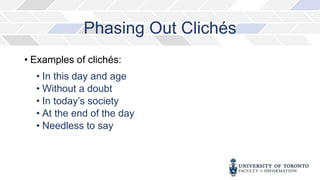

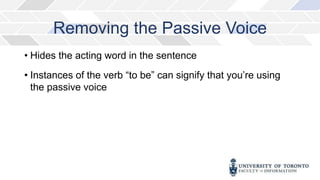

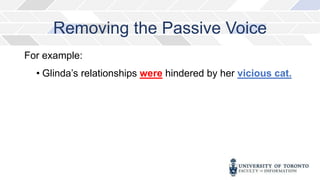

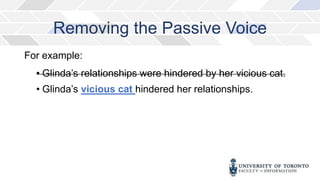
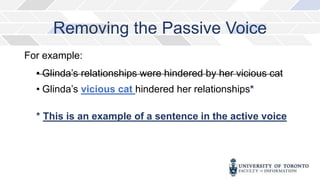


![References
McAuley, V. (2017). Citizen Lab: Leaks, Hacking, and Fake News. [blog post].
Retrieved from: http://digitaltattoo.ubc.ca/2017/07/25/17214/](https://image.slidesharecdn.com/writingclearly-170906001253/85/Writing-clearly-44-320.jpg)

